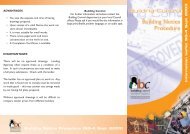RATS RATS - Carrickfergus Borough Council
RATS RATS - Carrickfergus Borough Council
RATS RATS - Carrickfergus Borough Council
You also want an ePaper? Increase the reach of your titles
YUMPU automatically turns print PDFs into web optimized ePapers that Google loves.
<strong>RATS</strong><br />
What do rats look like?<br />
The common rat typically has brownish fur on its back and is<br />
grey underneath, but colour can vary from white through to<br />
black. The adult body length is 200-270mm, plus a tail length<br />
of 150-200mm. The ship rat (smaller, black and with hairless<br />
ears) is nowadays rarely encountered in Britain. Rats have<br />
excellent senses of smell and taste. They have an acute sense<br />
of hearing, frequently using ultrasound to communicate, and<br />
are particularly sensitive to any sudden noise.<br />
Where do they live?<br />
Common rats live in any situation that provides food, water<br />
and shelter. In homes, they will live in roof spaces, wall<br />
cavities or under floorboards. In gardens, they will burrow<br />
into compost heaps and grassy banks or under sheds. Rats are<br />
often found living in sewer systems; they are agile climbers<br />
and excellent swimmers.<br />
What do they eat?<br />
The <strong>Council</strong> provides information leaflets on the<br />
following range of pests:<br />
Ants<br />
Bedbugs<br />
Cockroaches<br />
Fleas<br />
Flies<br />
Mice<br />
Pigeons<br />
Rats<br />
Slugs<br />
Spiders<br />
Wasps<br />
Pest Control Advice<br />
Preferred foods are cereal products, although rats are<br />
omnivorous and will eat almost anything that humans eat.<br />
Most damage caused by rats is through gnawing and ripping<br />
open packets of food. They also spoil and contaminate food<br />
with urine, droppings and hairs. Up to 5% of food produced<br />
worldwide is lost as a result of rodent activity. Unlike mice, rats<br />
require water every day.<br />
<strong>RATS</strong>
What are the signs of infestation?<br />
Sightings of live rats or droppings<br />
Rats are particularly active at night, but may be seen during the<br />
day searching for food, water or shelter.<br />
Common rat droppings are capsule-shaped, (tapered at both<br />
ends), black and up to 12mm long. A rat will leave about 40<br />
droppings a day. Fresh droppings will be soft and moist.<br />
Runs<br />
Rats follow the same routes when moving around and often<br />
leave trails through grass and low vegetation.<br />
Footprints, smears and tail swipes<br />
These can be seen on muddy or dusty surfaces. Smears are dark<br />
grey marks left on surfaces by repeated contact with the oils in<br />
rat fur.<br />
Burrows<br />
Rats can build complex tunnel systems, which often extend<br />
deep into the ground. Entrance holes 70-120mm in diameter<br />
will be seen in grassy banks, under tree roots and at the edge of<br />
paving or drain cover surrounds.<br />
Nests<br />
Sometimes nests can be found indoors, in lofts or under<br />
floorboards.<br />
Gnawing<br />
Rats gnaw continually to wear down their front teeth, even<br />
on non-food materials such as electrical cables, pipework and<br />
wooden fixtures.<br />
Why must rats be controlled?<br />
Rats can transmit many diseases to humans, including<br />
Salmonellosis (food poisoning) and Weils disease, usually from<br />
the urine of infected rats.<br />
Rats may also cause considerable damage to buildings,<br />
foundations and other structures due to gnawing and<br />
burrowing.<br />
How can I prevent rat infestation?<br />
Householders can assist in preventing rat infestation by<br />
taking a number of simple precautions.<br />
- Keep your home in good repair; rats only need a gap of<br />
15mm to gain entry.<br />
- Remove potential nesting sites by keeping yards and<br />
gardens clean and tidy, and by cutting back overgrown<br />
areas.<br />
- Ensure that drain inspection covers are in place and are in<br />
good repair.<br />
- Seal gaps around heating and water pipes.<br />
- Ventilation bricks and slots should already have a fine wire<br />
mesh incorporated. If this is worn, replace it externally<br />
with 3.15mm insect mesh.<br />
- Do not leave household waste where rats can get access to<br />
it, close dustbin lids and composters and do not feed wild<br />
birds to excess - you may be feeding rats as well.<br />
How can I get rid of rats?<br />
Rats are adaptable, highly mobile and breed rapidly to<br />
produce large rat infestations. This combination can make<br />
rat control a difficult task for the untrained individual.<br />
If you decide to carry out the work yourself there are two<br />
options –poison or break back traps:-<br />
Poison (rodenticide) can be bought from most hardware<br />
stores and most garden centres. Put the poison in a safe and<br />
secure place out of reach of children and pets and ALWAYS<br />
wash your hands after use. Use of rodenticide can take 4-12<br />
days to take effect. This may result in a localised foul smell<br />
due to the presence of carcasses.<br />
Break-back traps should be placed next to walls where rats<br />
tend to travel. The trap should be baited with chocolate,<br />
biscuit or cereal. Most rats are wary of new objects placed<br />
in their environment and will avoid them for a period of<br />
time. So do not set the spring on the trap until bait has been<br />
eaten then re-bait and reset the trap. Use several traps and<br />
examine them daily, removing dead rats as soon as they are<br />
discovered. All traps should be handled with care.<br />
Seek professional advice from the <strong>Council</strong>’s Environmental<br />
Health Service if you require any assistance.<br />
Warning: When using pesticides always follow the<br />
instructions on the label. Remember that pesticides may<br />
be harmful to other animals e.g. household pets etc.

















